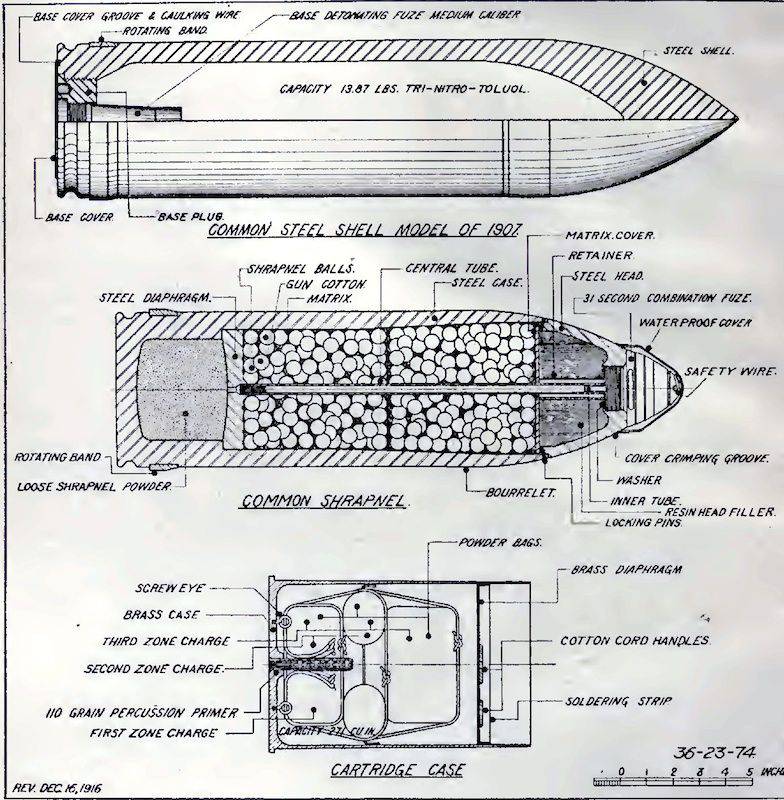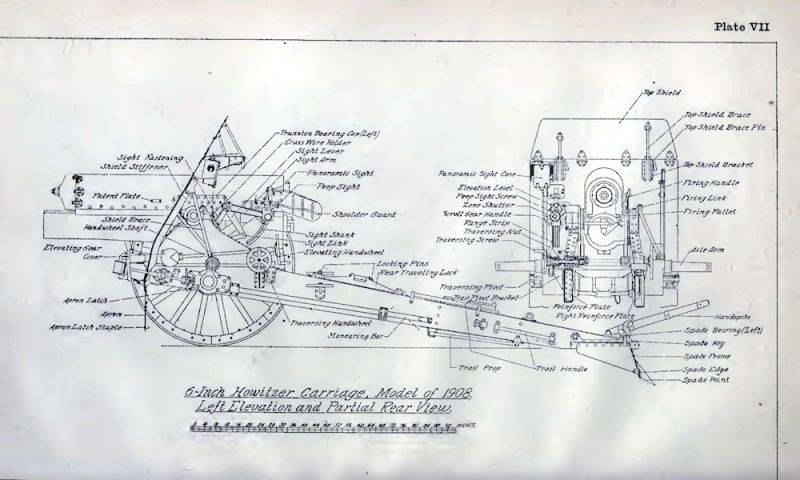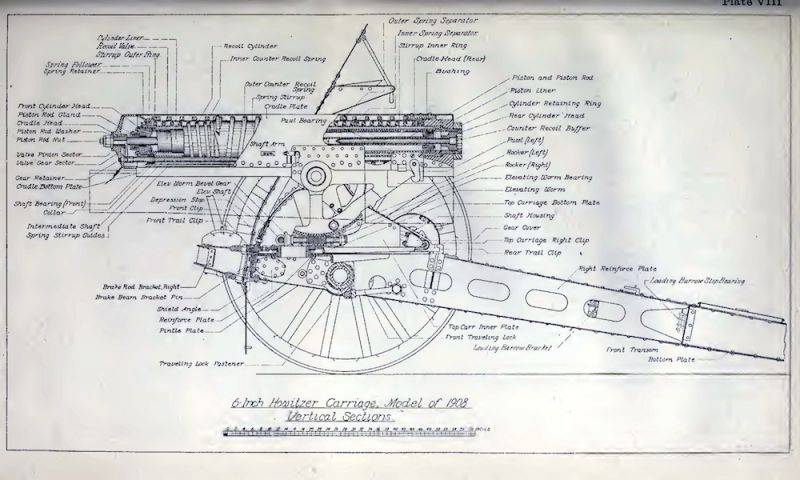Fateful six inches (part of 2)
The most massive weapon of this caliber in the German army on the eve of the First World War was the sFH 02 cannon of the 1902 sample. His trunk was shorter than the cradle, and it is easy to recognize him by this sign. In 1913, he was refined and named sFH 13, while he extended the trunk and changed the carriage. At the same time, the range of fire increased by 1000 m. It was these guns that opened fire on the enemy in August 1914, and before 1915, Krupp put this type of 252 sFH 13 howitzer. Spring recoil brake did not work very well, and it was replaced with a pneumatic one on new implements. Like all Germanic guns of the time (unlike the French ones), a horizontal wedge bolt was used on them. Production of the new howitzer was growing all the time, so that by the time the war ended, Krupp and Rheinmetall firms had 3,409 sFH13. The gun could fire projectiles weighing 40,5 — 42,0 kg and send 4 projectiles per minute to a distance of 8.500 m. At the same time, the combat weight of the gun was 2135 kg.
In Germany, as well as in France, and in other countries, in addition to the howitzer firing hinged fire, the 150-mm gun was also developed. The order for the development of such an instrument was given to Krupp in 1914, and it soon entered service. It had a barrel with a length of 42,7 gauges, vertical pointing angles from –3 ° to + 42 ° and horizon 8 ° in both directions. A shell weighing 52,5 kg it fired at a speed of 749 m / s. 22,8 km distance True, its weight was great - 10140 kg, and it could only be transported by a tractor. It began to be used at the front at the beginning of the 1917 of the year, and after the war, Belgium received some of these guns as reparations. And again, fate decreed so strangely that the same guns again found themselves in the German army already during the Second World War!
The 15-cm field gun iR L / 40 was a naval tool placed on a wheel set, as its very name said: "in Räderlafette", that is, "on a wheel set". It was produced in two versions, differing in different barrel lengths: L / 40 and L / 45. As is known, any naval weapon is more powerful than a land gun of the same caliber, but the price for this power is its greater weight. In this case, the weight of this gun was 11.820 kg. However, it turned out that with such a large weight, its firing range was relatively small: 18,7 km, and the weight of the projectile was only 44,2 kg. It fired from a special pallet, which added complexity in its installation in positions.
Interestingly, in Italy, speaking on the side of the Entente, the caliber of six-inch guns was even smaller - 149 mm. In fact, it was all the same Krupp howitzer, but under the Italian caliber. Launched it began in the year 1912. The weight of its projectile was 41 kg. Vertical guidance angles are 5 ° and + 43 °, and horizontal angles are 5 °. The initial velocity of the projectile was the smallest among the other guns of this caliber - only 300 m / s. Therefore, the firing range was small - 6800 m. After the war, this howitzer was replaced by 149-mm gun of the company Škoda, used by the Austro-Hungarian army under the designation 15cm Feldhaubitze M.14 and M.14 / 16. In the Italian army, it was used under the designation Obice 149 / 13.
The Da 149 / 35A cannon in the Italian army was an analogue of the German iR L / 40 cannon, and produced their factory in Terni, which also produced naval guns. The length of the barrel was less than the German - L / 35, but the whole structure is also very archaic: no recoil adaptations. However, the initial velocity of the projectile fired from it was 651 m / s, which ensured the firing range equal to 16,500 m. The high-explosive projectile weighed 42 kg, shrapnel - 43,4 kg. The weight of the gun in the combat position was 8,2 t. It was designed in 1905 year, but outdated at the time of adoption. It was transported by tractors with a speed of 6-8 km / h. The Italians used it in all the battles of the First World War and even during the Second World War, in particular during the Allied landings in Sicily.
Howitzer 15 cm Krupp Haubitze L / 12 fell into the service of Turkey, speaking ally of Germany and Austria-Hungary. The only noticeable difference from other similar systems to it was the recoil brake located above and not below the barrel, and in fact it was all the same howitzer sFH02 with a slightly shortened barrel. This arrangement pursued two goals: the first is to lower the center of gravity of the gun and make it more stable, and the second is to reduce the vibration after the shot, which loosened the mechanism. The first guns were tested in the 1911 year, and a year later they participated in both the Balkan wars, and then in the First World War.
However, this weapon came into service with the Turkish army after it had tested another Krupp development - a howitzer of the same caliber, the 1905 model of the year, made on the basis of the 1902 model of the year. A feature of the gun was a longer barrel (L / 14 versus L / 12), but both guns weighed about the same. They entered the army in 1908 and participated in the First World War. Its exact caliber was 149,1 mm, the angles of focusing are –5 ° and + 43 ° vertically and 5 ° horizontally. The weight of the shell 41 kg, range - 6.815 m.
At the beginning of the twentieth century, the United States professedly professed the “Monroe Doctrine” (“America for the Americans”), but they didn’t confuse themselves with European affairs. However, the American military got the idea to have a six-inch howitzer with a projectile weighing 40 kg. By the way, the standard NATO 155-mm projectile weighs 42 kg - over a hundred-plus years the weight has increased by only 2 kg!
In 1903, the US Armaments Department decided to adopt a howitzer, which is comparable in its characteristics to the German gun sFH02. The Waterlight arsenal in New York began to produce it, but before the war, all 100 units, which were designated as M1908 howitzers, were released - that is, 5 was developed and tested for years! And when the American soldiers went to Europe, they did not take these howitzers with them. Instead, the French offered them their six-inch shneiderovki!
What was interesting about this gun? Perhaps, only that he had a trunk under the “recuperator”, that is, a pullback brake, and had special protrusions on its surface along the entire length. The barrel had a long pullback of 1,60 m and a short 0,66 m (the latter at 40 ° rise). Again, it is interesting that the M1908 howitzer was originally developed for 54,4 kg shells, including shrapnel and grenades. But in the end they stopped on shells weighing 40 kg as the most long-range ones. As for the performance characteristics of this weapon, they are: caliber 152,4 mm, barrel length L / 13,5, weight in combat position 3439 kg, angles of vertical guidance: from –5 ° to + 40 °, on the horizon: 6 °. Initial speed charge No. 3: 274 m / s .; №2 - 192 m / s; №1 - 141 m / s. The maximum range of a projectile weighing 54,4 kg is 6130 m, and 40,8 kg is 8230 kg.
As for Russia, in this case one should start with the 152-mm cannon of the Obukhov plant, which is on display in the courtyard of the Central Museum of the Armed Forces of the Russian Federation in Moscow. It was a model 1877 of the year, on a high wheeled carriage, much like the French 120-mm cannon mle1878. For its caliber, it was relatively light - just 5,43 tons, but had no recoil fixtures other than linings under the wheels. This gun threw a grenade weighing 40,1 kg onto 14,2 km, which was quite a good indicator in 1914 year.
Well, when in Russia the question of adopting an 152-mm howitzer was adopted, the choice fell on the gun of the French firm Schneider. As a result, it was put into service in 1910, under the designation 152-mm fortress and field howitzer arr. 1909 d. It’s not quite clear how, but the following year, another such howitzer of the same company was put into service, differing from the first only in details. This howitzer was called the howitzer of the 1910 model of the year. The difference between them was only that the first trunk length was L / 14, and the second - L / 12,5. The weight of both systems was the same - 2725 kg, the projectile weighed 40 kg, however, the firing range, of course, differed. The first cannon has 10275 m, and the second has 9850 m. Both the elevation and horizontal guidance angles were the same: 41 ° and 6 °. The first was produced in large quantities, the second in quantities of very small. The first was upgraded in 1930, the second in 37, and both in the same way. They squandered the charging chamber, reducing the threaded part and increasing the volume of the liner with a charge. Both howitzers were used in the Russian imperial army, in the armies of whites and reds in the Civil War, and in the Red Army throughout the Great Patriotic War, and were also used in the armies of Germany, Romania and Finland.
What conclusion can be made on the basis of this information? All howitzers caliber 6 inches in World War I were very similar. The difference was in the location of the brake recoil and knurling: under the barrel or above it. The length of the barrel ranged from L / 12 to L / 15 and, accordingly, the firing range was also about the same. The length of the barrel of the guns was, naturally, more - to L / 42,7. Widely used naval guns, put on the wheel carriages. Just the barrel and carriage, like the guns 1812 year. Naturally, when they fired, they rolled back, which made it difficult to use them, and yet they were used throughout the war. The power of the shells was large enough, especially effective (for infantry) was shrapnel, which included bullets much more than the shells of 75-76-mm guns. Many high-explosive grenades had a bottom fuse and exploded, only plunging into the ground.

Shells and case with charge to the American six-inch howitzer M1908


Information